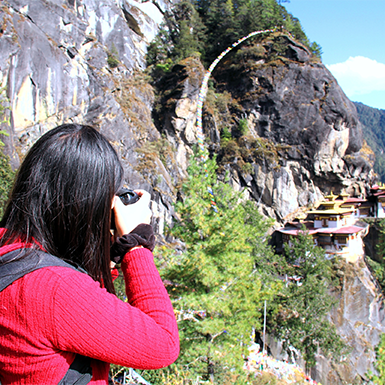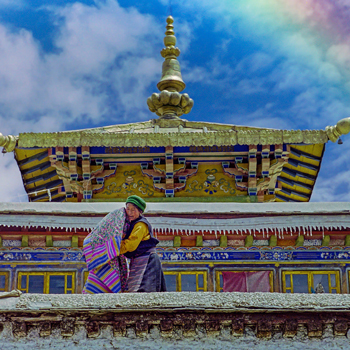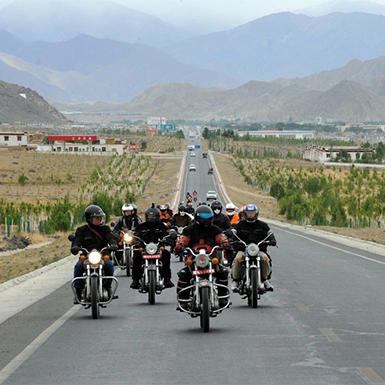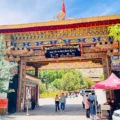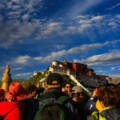The Shoton Festival, affectionately known as the “Yogurt Banquet Festival,” is a vibrant celebration deeply ingrained in Tibetan culture. This annual event traces back to the 11th century when locals offered yogurt to monks as they emerged from their summer seclusion. This simple act of generosity blossomed into a week-long extravaganza, seamlessly blending religious reverence with spirited celebrations.
Today, the festival paints a rich tapestry of cultural experiences. It showcases Tibet’s deep-rooted heritage through a captivating mix of religious ceremonies, artistic expressions, and communal gatherings. Locals and visitors unite to honor the region’s unique traditions and bask in the joyous atmosphere.
When and Where to Experience the Shoton Festival Magic
August in Lhasa: A Festival Beckons
The festival, which usually takes place in August and aligns with the Tibetan lunar calendar’s sixth month, turns Lhasa into a bustling activity center. However, the exact dates can shift slightly each year, so it’s always wise to confirm the official schedule before planning your trip.
Lhasa: The Heart and Soul of the Festival
The heart of the Sho Dun Festival beats within Lhasa, the captivating capital of Tibet. Iconic landmarks like the Norbulingka Palace, once the Dalai Lama‘s summer retreat, now burst with life and energy. The surrounding parks and open spaces transform into festive grounds, hosting various cultural events and gatherings.

Beyond the Palace: A Citywide Celebration
While the Norbulingka Palace takes center stage, the festivities radiate throughout Lhasa. Monasteries are crucial, especially during the awe-inspiring unveilings of intricate religious artwork that mark the festival’s commencement. Vibrant colors and melodies fill the streets as traditional Tibetan opera performances captivate audiences, while cultural exhibitions and bustling markets contribute to the city’s lively atmosphere.
Journey Through Time and Tibetan Tradition
The Shoton Festival’s roots intertwine deeply with Tibetan Buddhism and the region’s monastic heritage. This vibrant celebration began as a humble ritual within the religious community in the 11th century.
From Simple Offering to Cultural Extravaganza
Initially, the Shoton Festival honored monks who completed their annual summer retreat. Locals offered them yogurt, a refreshing treat after their seclusion. This gesture of appreciation gradually transformed into a grander celebration, incorporating various cultural and religious practices.
Tibetan Buddhism’s Enduring Influence
The festival’s connection to Tibetan Buddhism remains evident in its rituals and artistic expressions. A central highlight is the grand unveiling of thangkas, intricate religious scroll paintings often depicting Buddhist deities or significant historical figures. This unveiling holds profound spiritual significance for Tibetans.
Monastic Life and Festive Traditions
The Shoton Festival reflects the monastic tradition of ending the summer retreat. As monks re-emerged into society, the festival allowed them to connect with the local community and share their spiritual teachings through performances and discussions.
A Cultural Phenomenon
Over time, the Sho Dun Festival grew beyond its religious roots. It embraced elements of Lhamo, traditional music, and dance, evolving into a vibrant cultural spectacle. Today, it attracts travelers from every corner of the world, eager to experience its unique blend of spirituality and celebration.
Critical Elements of the Shoton Festival’s Historical Significance
- Yogurt Offerings: Offering yogurt to monks continues to symbolize respect and gratitude.
- Thangka Unveiling: This ritual holds deep spiritual meaning for the Tibetan people.
- Tibetan Opera: These performances offer insights into historical narratives and Buddhist teachings.
- Community Engagement: The festival fosters interaction between monks and the wider community.
Preserving Tibet’s Cultural Legacy
The Sho Dun Festival is a living testament to Tibet’s rich cultural heritage. The festival forges a living connection between past and future by keeping these traditions alive, allowing coming generations to embrace and cherish this remarkable region’s unique history and spiritual essence.
Lhasa Celebration Brimming with Tibetan Culture
The Shoton Festival in Lhasa is more than a single event—a week-long tapestry of experiences woven throughout the city. From spiritual ceremonies to lively performances and community gatherings, the festival offers a kaleidoscope of Tibetan cultural festivals.
The Grand Unveiling: Thangka at Drepung Monastery
One of the most awe-inspiring spectacles is the Thangka Exhibition at Drepung Monastery. This sacred ritual involves unfurling a massive thangka, an intricately detailed religious scroll painting, on a hillside behind the monastery. The thangka, often depicting Buddha or other revered figures, captivates with its artistry and devotion.
- A Visual Feast: Witness the thangka unfurl against the backdrop of the Tibetan landscape for a truly breathtaking sight. The vibrant colors, intricate details, and size of the thangka create an unforgettable visual impact.
- Spiritual Significance: For Tibetans, the thangka exhibition is a profoundly spiritual moment, symbolizing blessings and good fortune for the coming year.
- Photographer’s Delight: This event presents incredible photo opportunities, capturing the unique blend of art, religion, and cultural tradition.
Tibetan Opera: A Lively Spectacle
Another highlight of the Shoton Festival is the abundance of Lhamo performances. Known as “Lhamo,” this traditional art form combines music, dance, and dramatic storytelling to portray historical events and religious narratives.
- Norbulingka Palace Stage: The gardens transform into a vibrant stage for Lhamo performances, attracting enthusiastic crowds eager to experience this cultural treasure.
- Public Performances Throughout Lhasa: Opera troupes also perform in various public spaces throughout Lhasa, ensuring accessibility for all.
- Colorful Costumes and Masks: The actors’ elaborate costumes and masks add visual richness to the operas.

The elaborate costumes, expressive masks, and dynamic movements of the performers bring ancient stories and legends to life, captivating audiences of all ages.
Beyond Opera and Thangkas: A Myriad of Activities
The Sho Dun Festival offers diverse activities beyond religious rituals and opera performances. Here’s a sampling:
- Cultural Exhibitions: Discover exhibitions showcasing Tibetan art, handicrafts, and traditional attire.
- Sporting Events: Watch thrilling yak races, skillful horsemanship competitions, and other traditional Tibetan sports.
- Festive Picnics and Gatherings: Join locals for lively picnics in parks and gardens, savoring traditional Tibetan cuisine and the joyful atmosphere.
- Religious Debates: Observe engaging debates among monks on Buddhist philosophy and doctrine.
Planning Your Shoton Festival Experience
When planning your trip to the Sho Dun Festival in Lhasa, consider these helpful tips:
- Check the Festival Schedule: The festival’s schedule may vary slightly each year, so confirm the dates and times of specific events before you go.
- Book Tickets for Performances: Some events, such as the Lhamo performances, may require tickets. Purchase them early to guarantee your seat.
- Allow Ample Time: The festival spans a week, so allocate enough time to fully experience the diverse range of activities available.
- Embrace the Festive Spirit: The Sho Dun Festival is a time for celebration and joy. Connect with the locals, savor new flavors, and experience the rich tapestry of Tibetan culture firsthand.
Cultural Significance: A Tapestry Woven Through Time
- Tibetan Heritage on Display: The Shoton Festival is a vibrant showcase of Tibet’s rich cultural heritage. The festival honors centuries-old traditions and customs in every facet, from the grand thangka unveilings to the mesmerizing Lhamo performances.
- A Celebration of Identity: For Tibetans, this festival is a powerful expression of their unique identity. It’s a time to celebrate their language, art, music, and way of life, fostering a deep sense of pride and unity within the community.
- Cultural Exchange: The festival also welcomes visitors from around the globe, providing a platform for cultural exchange and understanding. By sharing traditions and experiences, the Sho Dun Festival builds bridges between diverse cultures.
Spiritual Significance: A Time of Renewal and Reflection
- Rooted in Tibetan Buddhism, the Shoton Festival’s origins are deeply intertwined with Tibetan Buddhism. The thangka exhibitions, spirited religious debates, and yogurt offerings to monks embody the festival’s spiritual core.
- A Fresh Start: For many Tibetans, the festival marks a time of renewal and purification. It’s an opportunity to release negativity and embrace a fresh beginning for the year ahead.
- Blessings for the Community: Many believe that the unveiling of the thangka showers blessings and good fortune upon the community, fostering a sense of hope and optimism for the future.
Community Celebration: Togetherness and Joy
- Shared Heritage: The Shoton Festival is a time for Tibetans to come together and celebrate their shared cultural heritage. The festive atmosphere sparks interactions and connections among people of all ages.
- Picnics and Festivities: Families and friends gather for joyous picnics in parks and gardens, sharing delicious food and laughter. This communal spirit strengthens social bonds and creates a deep sense of belonging.
- Contagious Joy: The festival’s lively atmosphere is infectious. The vibrant colors, energetic music, and enthusiastic crowds generate an environment of pure joy and celebration that uplifts everyone’s spirits.
Shoton Festival: Your Guide to a Tibetan Cultural Adventure
The Shoton Festival in Lhasa offers more than just a festival. It’s a complete cultural immersion. From the moment you step foot in Lhasa, Tibet’s vibrant sights, sounds, and flavors will surround you. Here’s what you can anticipate as a visitor, along with practical tips for making the most of the festival’s highlights:
Thangka Exhibition: Witnessing a Sacred Spectacle
The Thangka Exhibition at Drepung Monastery is a must-see event for any visitor. Here’s how to optimize your experience:
Arrive Early for the Best Views: The unveiling typically occurs early in the morning, so get ahead of the crowds to secure a prime viewing location.
Choose Your Vantage Point Wisely
- The Hillside: Hike up the hillside behind the monastery for sweeping panoramic views.
- The Monastery Courtyard: Get closer to the action in the courtyard, but be prepared for limited space.
- Rooftop Views: Some nearby buildings offer rooftop access for a unique perspective.
Bring Binoculars for a Closer Look: Enhance your appreciation of the thangka’s intricate details by bringing binoculars.
Respect the Ceremony’s Sacred Nature: This is a profoundly spiritual event for Tibetans. Maintain a respectful demeanor and refrain from disruptive behavior.
Lhamo: Engaging with a Living Tradition
Lhamo is a vibrant expression of Tibetan culture and storytelling. Here’s how to embrace it at the Shoton Festival:
- Catch Performances at the Norbulingka Palace: The palace gardens are the main stage for Lhamo performances. Check the festival program for showtimes and secure your tickets in advance if needed.
- Discover Spontaneous Performances: Watch for impromptu performances in public squares and parks throughout Lhasa.
- Delve into the Stories: Familiarize yourself with Lhamo’s basic plots and characters beforehand to enhance your enjoyment of the performances.
- Connect with the Performers: Feel free to approach the performers for photos or engaging conversations about their craft after the show.
Festive Fun: Beyond the Main Events
The Shoton Festival is more than its marquee events. The entire city buzzes with a celebratory atmosphere, offering ample opportunities for cultural exploration:
- Meander Through Markets: Explore local markets with Tibetan handicrafts, unique souvenirs, and tempting street food.
- Share a Picnic with Locals: Join communal picnics in parks and gardens. It’s a fantastic way to connect with locals and sample traditional Tibetan cuisine.
- Attend Cultural Exhibitions: Delve into Tibetan art, history, and customs at exhibitions scattered throughout the city.
- Experience Lhasa After Dark: The city’s nightlife comes alive during the festival, with bars and restaurants offering special events and live music.

Essential Travel Tips
Are you ready for an unforgettable tour of the heart of Tibetan culture? The Shoton Festival in Lhasa promises an experience unlike any other. Here’s your practical travel guide to help you plan your adventure:
When to Go: Timing Your Trip for the Festivities
The Sho Dun Festival typically takes place in August, coinciding with the sixth month of the Tibetan lunar calendar. Remember that exact dates vary yearly, so verify the official schedule before booking your flights and accommodations. August in Lhasa usually offers pleasant weather with warm temperatures and occasional rain showers. Pack layers and rain gear for a comfortable experience.
Where to Stay: Finding the Perfect Accommodation
Lhasa offers diverse accommodations, from luxurious hotels to budget-friendly guesthouses and hostels. Book well in advance, especially if you plan to visit during the festival when hotels tend to fill up quickly. Choose a place near the Norbulingka Palace or Barkhor Street if you prefer to be in the center of the action.
Getting to Lhasa: Navigating Your Traveling to Shoton Festival
You can reach Lhasa by flying into Lhasa Gonggar Airport, which connects to major cities in China. Alternatively, you can take the scenic Qinghai-Tibet Railway from various cities in China. Once in Lhasa, taxis and buses provide convenient transportation options.
Cultural Etiquette: Respect and Appreciation
Respecting Tibetan culture and customs is crucial for a positive and enriching experience:
- Dress Respectfully: Pack clothing that covers your shoulders and knees as Tibetans dress modestly, particularly when visiting religious sites.
- Ask Before Photographing: Always ask permission before taking pictures of people, particularly monks and nuns.
- Show Reverence for Sacred Sites: Maintain a respectful demeanor at monasteries, temples, and other religious sites by avoiding loud conversations and disruptive behavior.
- Learn a Few Tibetan Phrases: Learning a few simple Tibetan phrases, like “Tashi Delek” for hello and “Thuk-je-che” for thank you, is a gesture of respect that can open doors and create meaningful connections with the local people.
- Be Patient: Embrace the relaxed pace of life in Tibet and exercise patience if you encounter delays or misunderstandings.
Extra Tips for an Amazing Shoton Festival Adventure
- Prepare for Altitude: Lhasa’s high altitude can cause altitude sickness. Acclimatize gradually, drink plenty of water and consult your doctor about medication if you are prone to altitude sickness.
- Indulge in Local Cuisine: Savor the unique flavors of Tibetan dishes like momos (dumplings), thukpa (noodle soup), and yak butter tea.
- Embrace Tibetan Hospitality: Tibetans are known for their warmth and friendliness. Unforgettable experiences begin with local encounters. Engage with locals, explore their traditions, and create memorable experiences.
Shoton Festival: A Celebration That Transforms Tibet
The Shoton Festival Lhasa is not just a celebration; it actively shapes and enriches Tibetan society through cultural preservation, economic growth, and global exchange.
Living Legacy: Preserving Tibetan Culture
The festival guards Tibet’s rich heritage, ensuring ancient traditions thrive for generations.
- Thangka Unveiling: The grand unveiling of intricate thangka paintings celebrates Tibetan artistry and spiritual devotion, ensuring the continuation of this sacred art form.
- Tibetan Opera (Lhamo): The festival provides a vital platform for Lhamo performances, allowing this unique form of storytelling and artistic expression to flourish. These operas safeguard historical narratives, Buddhist teachings, and traditional Tibetan values.
- Cultural Exhibitions: By highlighting Tibetan art, handicrafts, costumes, and cuisine, the festival cultivates an appreciation for the region’s diverse culture and skilled craftsmanship.
A Tourism Magnet: Opening Doors to Tibetan Culture
The Shoton Festival attracts visitors worldwide, offering a unique opportunity to experience Tibetan culture firsthand, boosting the local economy, and creating employment.
- Economic Boost: Local businesses, including hotels, restaurants, shops, and tour operators, significantly benefit from the surge of tourists during the festival.
- Cultural Exchange: The festival generates significant benefits for both locals and tourists. This exchange of ideas and perspectives enriches both groups and promotes understanding and appreciation of different cultures.
- Sustainable Practices: As tourism grows, ongoing efforts strive to ensure sustainability and benefit the local community. These initiatives aim to preserve the environment and support local businesses.
International Cultural Exchange: Building Bridges
The Shoton Festival transcends geographical boundaries, acting as a vibrant hub for international cultural exchange. It draws scholars, artists, and enthusiasts from diverse countries, fostering dialogue and collaboration.
- Academic Gatherings: The festival often hosts academic conferences and seminars on Tibetan culture, history, and Buddhism, uniting experts worldwide to share knowledge and insights.
- Artistic Collaborations: Artists from different backgrounds participate in the festival, showcasing their work and collaborating with Tibetan artists. This fusion of artistic styles enriches the cultural landscape.
- Global Spotlight: The festival highlights Tibet’s unique cultural heritage internationally. Media coverage and word-of-mouth spark widespread interest in Tibetan traditions and entice travelers to visit the region.
Personal Stories from the Heart of Tibet
The Shoton Festival Lhasa is more than just grand events and performances; it’s a tapestry of personal connections, unexpected moments, and cherished memories. Here’s what some festival-goers have to say about their experiences:
Thangka Unveiling: Awe-Inspiring and Spiritual
- “As the sun peeked over Drepung Monastery, a hush descended upon the crowd. Then, with a collective gasp, the massive thangka unfurled, revealing its vibrant colors and intricate details. A wave of emotion washed over me, a feeling of awe and wonder that will forever remain etched in my memory.” – Sarah, a traveler from Canada.
- “The Thangka Exhibition transcended mere visual spectacle; it was a profound spiritual experience. I felt deeply connected to the Tibetan Buddhist faith and its time-honored traditions.” – Tenzin, a Tibetan monk.
Tibetan Opera: A Journey into Enchantment
- “The Lhamo performances at Norbulingka Palace were utterly captivating,” raved David, a photographer from the UK. “The costumes, the music, the stories… it was like stepping into another world. The performers’ passion and energy were mesmerizing.”
- “I had the incredible opportunity to meet some opera performers after a show. They welcomed me with open arms and eagerly shared their knowledge of Lhamo. It was a truly enriching cultural exchange.” – Pema, a student from China.
Festival Atmosphere: Joy, Laughter, and Shared Moments
- “The Sho Dun Festival is a time for pure joy and shared celebration. I loved wandering through the bustling markets, sampling delicious street food, and spontaneously joining picnics in the parks. The atmosphere was electric!” – Maria, a backpacker from Spain.
- “One magical evening, I stumbled upon a group of locals singing and dancing in the streets. They invited me to join their impromptu revelry, and we danced under the moonlight. It was an unforgettable moment of pure joy and connection.” – Wangchen, a resident of Lhasa.
A Photographer and Videographer’s Guide to Capturing Tibetan Culture
The Shoton Festival Lhasa presents a visual feast, offering photographers and videographers a chance to capture the essence of Tibetan culture. However, documenting this vibrant event goes beyond technical expertise; it involves respecting local customs and understanding the spiritual significance behind the festivities. Here’s how to report your experience responsibly and creatively:
Photography Tips for the Shoton Festival
Thangka Unveiling
- Showcase the Grandeur: Employ a wide-angle lens to encapsulate the thangka’s immense size against the awe-inspiring Tibetan landscape.
- Highlight the Details: Switch to a telephoto lens to emphasize the thangka’s intricate details and artistry.
- Embrace the Light: The morning light bathes the unveiling in a magical glow. Experiment with various angles and exposures to create stunning photographs.
Tibetan Opera (Lhamo)
- Convey Emotion: Focus on the performers’ expressive faces and dynamic movements to capture the drama and emotion of the opera.
- Freeze the Action: Utilize a fast shutter speed to freeze the intricate dance steps and vibrant costumes in sharp detail.
- Explore Different Angles: Shoot from various perspectives to add visual interest to your images. Experiment with low angles to accentuate the grandeur of the costumes or high angles to capture the full scope of the performance.
Other Festivities
- People Portraits: Capture the joy and excitement of festival-goers, but remember to ask permission before taking close-up portraits.
- Candid Moments: Seek out genuine moments of interaction between people, monks, and performers to tell authentic stories through your images.
- Street Life: Document the bustling markets, colorful processions, and lively street performances to capture the festival’s vibrant atmosphere.
Videography Tips for the Shoton Festival
- Stabilize Your Shots: Use a gimbal or tripod to ensure smooth, stable footage, especially during the thangka exhibition and opera performances.
- Record the Soundscape: Capture the festival’s unique sounds—the chanting of monks, the melodic opera music, and the joyous laughter of the crowd. These audio elements will enrich your video.
- Capture the Ambience: Don’t limit your focus to the main events. Pan your camera to capture the overall ambiance, including the festive decorations, bustling food stalls, and people enjoying the festivities.
- Interview Locals: If given the opportunity, interview locals to gain their perspectives on the festival and its significance. Adding this information will add depth and context to your video.
Sharing Your Creations: Respect and Responsibility
- Seek Permission: Always ask permission before photographing or filming individuals, especially monks and nuns.
- Be Mindful of Sacred Spaces: Respect the festival’s spiritual nature. Avoid using flash photography during religious ceremonies and disrupting performances.
- Share with Context: When sharing your images and videos online, provide context and respect the festival’s cultural significance. Please share your pictures and videos responsibly, ensuring they do not disrespect or offend anyone.

